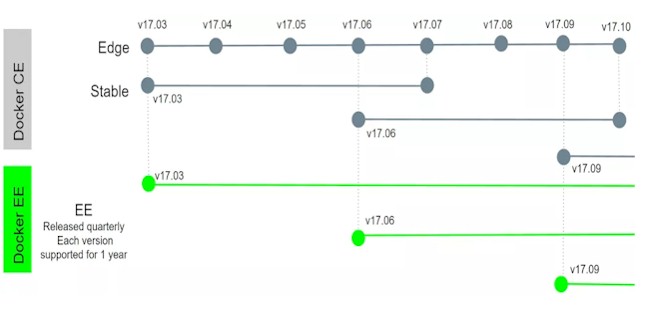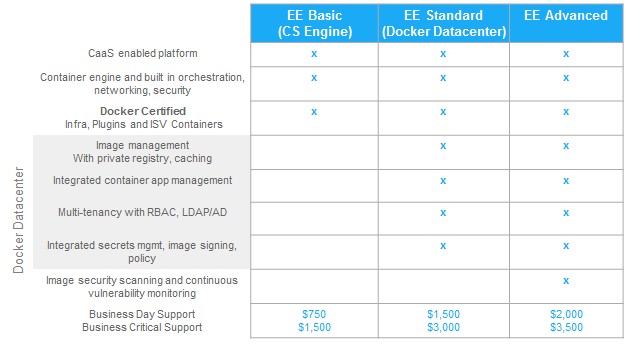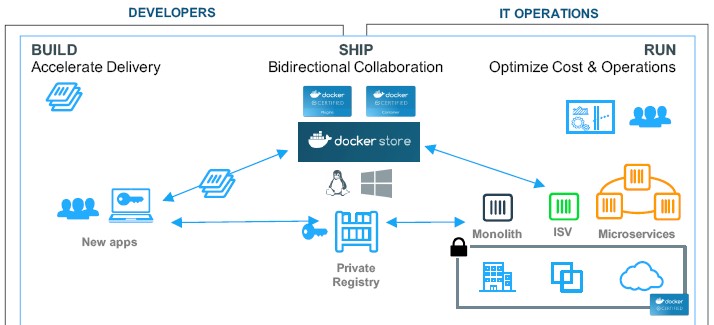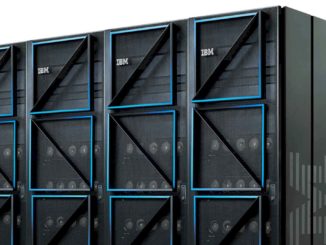
In the server virtualization era, there were a couple of virtual machine formats and hypervisors to match them, and despite the desire for a common VM format, the virtual server stacks got siloed into ESXi, KVM, Xen, and Hyper-V stacks with some spicing of PowerVM, Solaris containers and LDOMs, and VM/ESA partitions sprinkled on.
With containers, the consensus has been largely to support the Docker format that was inspired by the foundational Linux container work done by Google, and Docker, the company, was the early and enthusiastic proponent of its way of the Docker way of doing containers.
Now, Docker is ready for the enterprise, and with something it calls, appropriately enough, Docker Enterprise Edition. If this were the 1980s, we might make a joke about how Docker has shifted from khakis and oxford shirts to a pinstripe suite, but today there is no obvious analog. You can’t tell who someone is by how they dress at the office – particularly in Silicon Valley and particularly in the datacenters and programming cubicles of the world – and perhaps that is a good thing.
There are so many ways to bring Docker containers into the datacenter that it is hard to keep track of them all. The market is much less consolidated than, say, the early days of Linux, when there were a handful of distributions and Red hat quickly emerged as the enterprise favorite and CentOS, its clone, emerged as the development and freebie favorite, essentially doubling its installed base. There are those that pay for support for open source software and those that do not, and that, say executives at Docker, is why the company is splitting its code base into a Community Edition and an Enterprise Edition. Docker, the company, has pulled in $180 million in four rounds of venture funding, and its investors want to build a company that generates revenues and profits and that can go public at some point and allow them to cash out as big winners.
The Enterprise Edition announced this week leverages all of the hard work that went into making elements of this stack over the past several years –the Compose container maker, the Datacenter management tool, and the Swarm container controller as well as the Docker runtime and its new “secrets” security paradigm are the key elements. This is not a new set of code so much as a declaration, a rejiggering of the development cadence to match the needs of developers and operators who like to be near the bleeding edge and enterprise datacenters who want to hang back a bit, and a pricing and packaging scheme to match the needs of all parties.
The declaration of enterprise readiness is in the name. As for the Docker development cadence, Docker is splitting its code base into two versions. The Community Edition is aimed at the DevOps crowd and will have a monthly update for all the hottest features being added for developers; this is called an Edge release, and it is supported for four months, providing one month of overlap with the next release. A quarterly rollup of the Community Edition, called a Stable release, will be aimed at those on the operations team who want to be on the leading edge but not so close as to get cut. The first Community Edition will use a year-month naming convention, so this first one will be called 17.03. The Enterprise Edition will have quarterly releases and backporting of security patches for a year on each quarterly release; in other words, each Enterprise Edition release has a year of support. Here is what the release roadmap looks like:
 We think that, over time, as Docker gets mature, it will offer long-term support on Enterprise Edition releases, perhaps for as long as five years, as the big Linux distros do. But we are not at that stage of container development yet, so this could take a year or two to reach that level of completeness for the Docker stack.
We think that, over time, as Docker gets mature, it will offer long-term support on Enterprise Edition releases, perhaps for as long as five years, as the big Linux distros do. But we are not at that stage of container development yet, so this could take a year or two to reach that level of completeness for the Docker stack.
The other thing that Enterprise Edition brings to Docker customers is a guarantee that the Docker stack will run on certain private and public platforms and be backed by enterprise-grade support. (As with other open source tools, those using Community Edition are supported through the community and expected to be somewhat self-reliant, particularly since they are not paying anything to use the software.) That cross-platform capability is what businesses large and small all want, and it is arguable that Docker has given the industry the first true cross-platform application substrate that frees them from the confines of any particular underlying infrastructure.
Enterprise Edition is certified Red Hat Enterprise Linux and its CentOS clone, Canonical Ubuntu Server, SUSE Linux Enterprise Server, Oracle Linux, and Microsoft Windows Server 2016 on private iron, and is also available on Linux instances on the Amazon Web Services and Microsoft Azure public clouds. That covers most of the enterprise bases. (Docker Community Edition runs on MacOS and Windows 10 as well as CentOS, Debian, Fedora, and Ubuntu desktop operating systems and is available for free from the Docker Store. You could probably get it to work on other Linux and Windows Server versions, if you were so compelled.)
Together, the two editions span the gamut of how containers are used in IT shops.
Being a commercial product aimed at large enterprises, Enterprise Edition has various SKUs and prices to match, as you can see above. The feature sets correspond to prior CS Engine and Docker Datacenter products, and the per node pricing is on the same order of magnitude as a Linux distribution with business day and continuous tech support.
We can’t judge how ready Docker is now for the enterprise – we can only say that Docker thinks it is ready and then see what the tens of millions of possible enterprise customers – and perhaps there are a few tens of thousands who really matter at this stage of containerization in the datacenter – have to say as they deploy this technology. At some point, we will be able to count the money to prove it.
What we want to know is if the creation of an Enterprise Edition will help accelerate adoption of commercial Docker in the enterprise. We know full well how developers and startups love the open source code, and we have seen the download numbers for Docker that are the classic hockey stick.
“We do think that enterprise adoption can go even faster,” David Messina, senior vice president of marketing at Docker, tells The Next Platform. “It comes back to Docker’s core principles, and the reason why it was adopted so quickly is because these were simple. It is a uniform packaging format that works on any platform, with a common API and a common tooling for development and operations. That remains the case, and with certification programs, and that provides us differentiation against anyone else providing a platform, including Red Hat, which has a format that only works on RHEL, which is not what enterprises are looking for. What we are making clear is that we are hitting all of the high marks for applications, and not just microservices, but big packages like SQL Server, which is behind so many of the .NET applications out there. So many enterprises are just lifting and shifting monoliths into containers. And what our container as a service approach allows for all applications to be put into the same supply chain and we can support the whole life cycle. Having these software partners will help further drive adoption.”
Patrick Chanezon, who joined Docker in March 2015 as a member of the technical staff and who is in charge of the new enterprise packaging and approach and who has had stints at Google, VMware, and Microsoft related to scale out software infrastructure, hits the hammer on the head regarding how Docker will be embraced by enterprises, and why.
“Working on these various platforms, from App Engine to Cloud Foundry to Azure, what I see now is that we are at the point where enterprises want to move from the datacenter to a hybrid architecture, both hybrid cloud and multi-cloud,” says Chanezon. “For that, they want that layer of compatibility and portability, and I saw this when I was at Azure for workloads that customers wanted to run inside their firewalls and across several public clouds. With all of the features we have now, we think Enterprise Edition is coming to market at just the right time.”







Be the first to comment